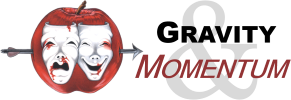Stage Combat Theory
Programming Movement
We learn things one step at a time. No matter how much of a “multi-tasker” you think you are, the reality is that your brain is switching from one thing to another very rapidly.
When you are learning a new, complex physical skill, like stage combat, your brain can only focus on one aspect of the new technique at a time. This is why when you first throw a punch or pick up a sword you feel completely uncoordinated.
As you start to become familiar and comfortable with techniques the brain lumps the individual commands into larger, more general commands. For example: The individual commands (and many more of even finer detail) rotate right shoulder up, lift elbow, wrist, and hand to be in line with each other at shoulder level, curl each finger loosely into the palm; get lumped into “Cue Right Roundhouse.”
Just like with verbal language, you create physical symbols to execute a broader meaning in a more efficient way. The individual commands are like the alphabet. When you get that down you can form words. After that you can take those words and make any sentence you like. “Cue” is a symbol representing its own deep subsection of commands, “right” refers to all the commands for a particular side of the body, “roundhouse” as well is a general symbol of all the actions needed to execute the desired movement.
Another way to look at it is like a computer program. For those who remember, we used to have to bring up the DOS prompt and type in a string of commands to execute a program. Now we have shortcuts that we double click and the program runs. The commands we entered before still happen, we just don’t have to think about them. Your brain sets up physical movement in a similar way. If you had to think about every minute command needed to walk you would fall flat on your face. Instead you can just think the “shortcut” walk, and off you go.
What this means is to take your time learning something new and do not be hard on yourself in the beginning. Everyone goes through this exact same process. Some move faster simply because they already have a similar physical vocabulary to build on.
Break each new move down to its components (which you will be amazed to discover how similar they are to every day movements) and work from there. It is vital that you go at your own pace to get the alphabet correct in the beginning. If your “pronunciation” is off your “words” won’t sound right.
